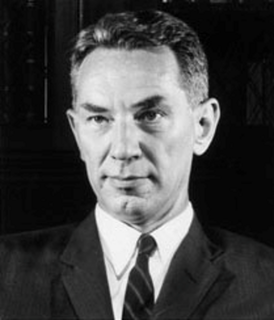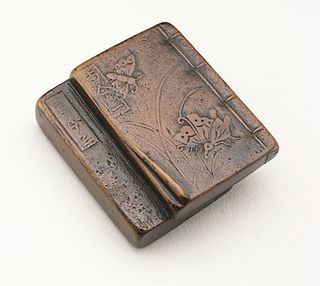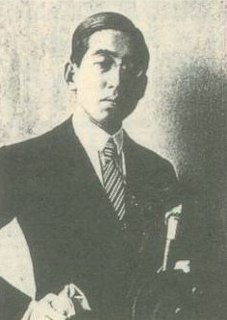Tanka is a genre of classical Japanese poetry and one of the major genres of Japanese literature.

The Tale of Genji is a classic work of Japanese literature written in the early 11th century by the noblewoman and lady-in-waiting Murasaki Shikibu. The original manuscript, created around the peak of the Heian period, no longer exists. It was made in "concertina" or orihon style: several sheets of paper pasted together and folded alternately in one direction then the other.

Japanese literature throughout most of its history has been influenced by cultural contact with neighboring Asian literatures, most notably China and its literature. Early texts were often written in pure Classical Chinese or lit. 'Chinese writing', a Chinese-Japanese creole language. Indian literature also had an influence through the spread of Buddhism in Japan.

The Ryukyuan people are an East Asian ethnic group native to the Ryukyu Islands, which stretch between the islands of Kyushu and Taiwan. Administratively, they live in either the Okinawa Prefecture or the Kagoshima Prefecture within Japan. They speak one of the Ryukyuan languages, considered to be one of the two branches of the Japonic language family, the other being Japanese and its dialects. Hachijō is sometimes considered by linguists to constitute a third branch.
Hiraide Shū was a novelist, poet, and lawyer in late Meiji period Japan. As a lawyer, he was noted for his involvement in the defense of the accused in the High Treason Incident.

Hakushū Kitahara is the pen-name of Kitahara Ryūkichi, a Japanese tanka poet active during the Taishō and Shōwa periods of Japan. He is regarded as one of the most popular and important poets in modern Japanese literature.

Lieutenant-General Mori Rintarō, known by his pen name Mori Ōgai, was a Japanese Army Surgeon general officer, translator, novelist, poet and father of famed author Mari Mori. He obtained his medical license at a very young age and introduced translated German language literary works to the Japanese public. Mori Ōgai also was considered the first to successfully express the art of western poetry in Japanese. He wrote many works and created many writing styles. The Wild Geese (1911–1913) is considered his major work. After his death, he was considered one of the leading writers who modernized Japanese literature.

Edwin Oldfather Reischauer was an American diplomat, educator, and professor at Harvard University. Born in Tokyo to American educational missionaries, he became a leading scholar of the history and culture of Japan and East Asia. Together with George M. McCune, a scholar of Korea, in 1939 he developed the McCune–Reischauer romanization of the Korean language.

Yosano Akiko was the pen-name of a Japanese author, poet, pioneering feminist, pacifist, and social reformer, active in the late Meiji period as well as the Taishō and early Shōwa periods of Japan. Her name at birth was Shō Hō. She is one of the most noted, and most controversial, post-classical woman poets of Japan.

Japanese poetry is poetry typical of Japan, or written, spoken, or chanted in the Japanese language, which includes Old Japanese, Early Middle Japanese, Late Middle Japanese, and Modern Japanese, as well as poetry in Japan which was written in the Chinese language or ryūka from the Okinawa Islands: it is possible to make a more accurate distinction between Japanese poetry written in Japan or by Japanese people in other languages versus that written in the Japanese language by speaking of Japanese-language poetry. Much of the literary record of Japanese poetry begins when Japanese poets encountered Chinese poetry during the Tang dynasty. Under the influence of the Chinese poets of this era Japanese began to compose poetry in Chinese kanshi); and, as part of this tradition, poetry in Japan tended to be intimately associated with pictorial painting, partly because of the influence of Chinese arts, and the tradition of the use of ink and brush for both writing and drawing. It took several hundred years to digest the foreign impact and make it an integral part of Japanese culture and to merge this kanshi poetry into a Japanese language literary tradition, and then later to develop the diversity of unique poetic forms of native poetry, such as waka, haikai, and other more Japanese poetic specialties. For example, in the Tale of Genji both kanshi and waka are frequently mentioned. The history of Japanese poetry goes from an early semi-historical/mythological phase, through the early Old Japanese literature inclusions, just before the Nara period, the Nara period itself, the Heian period, the Kamakura period, and so on, up through the poetically important Edo period and modern times; however, the history of poetry often is different from socio-political history.

Myōjō was a monthly literary magazine published in Japan between April 1900 and November 1908. The name Myōjō can be translated as either Bright Star or Morning Star.

Daigaku Horiguchi was a poet and translator of French literature in Taishō and Shōwa period Japan. He is credited with introducing French surrealism to Japanese poetry, and to translating the works of over 66 French authors into Japanese.
Tatsuhiro Ōshiro was an Okinawan novelist and playwright from Okinawa, Ryukyu Islands.
Shun Medoruma is a Japanese writer, who, along with Ōshiro Tatsuhiro, Sakiyama Tami, and Matayoshi Eiki, is one of the most important contemporary writers from Okinawa, Japan. Early in his career he won the 11th Ryukyu Shimpō Short Story Prize in 1983 for "Taiwan Woman: Record of a Fish Shoal" ("Gyogunki"), translated by Shi-Lin Loh in Islands of Protest: Japanese Literature from Okinawa, and the New Okinawan Literature Prize in 1986 for "Walking the Street Named Peace Boulevard". He was awarded the 27th Kyushu Arts Festival Literary Prize and the 117th Akutagawa Prize in 1997 for his short story "A Drop of Water" ("Suiteki"). In 2000 his short story "Mabuigumi" won the prestigious Kawabata Yasunari and Kiyama Shōhei literary prizes. Medoruma also wrote the screenplay for the film Fūon:The Crying Wind, which received the Montreal Film Festival Innovation Prize in 2004, and published a novel based on the screenplay the same year. His critically acclaimed novel In the Woods of Memory is the first full-length novel by an Okinawan writer to be translated and published in English.

Sakutarō Hagiwara was a Japanese writer of free verse, active in the Taishō and early Shōwa periods of Japan. He liberated Japanese free verse from the grip of traditional rules, and he is considered the "father of modern colloquial poetry in Japan". He published many volumes of essays, literary and cultural criticism, and aphorisms over his long career. His unique style of verse expressed his doubts about existence, and his fears, ennui, and anger through the use of dark images and unambiguous wording.
Rapes during the occupation of Japan were war rapes or rapes committed under the Allied military occupation of Japan. Allied troops committed a number of rapes during the Battle of Okinawa during the last months of the Pacific War and the subsequent occupation of Japan. The Allies occupied Japan until 1952 following the end of World War II and Okinawa Prefecture remained under US governance for two decades after. Estimates of the incidence of sexual violence by Allied occupation personnel differ considerably.

Turtleback or Turtle-back tombs or turtle shell tombs are a particular type of tombs originating from the Song Dynasty. They are commonly found in some coastal provinces of southern China, the Ryukyu Islands of Japan, and in Vietnam. They can also be found in countries with overseas Chinese populations like Malaysia.
The Ryukyuan diaspora are the Ryukyuan emigrants from the Ryukyu Islands, especially Okinawa Island, and their descendants that reside in a foreign country. The first recorded emigration of Ryukyuans was in the 15th century when they established an exclave in Fuzhou in Ming Dynasty (China). Later, there was a large wave of emigration to Hawaii at the start of the 20th century, followed by a wave to various Pacific islands in the 1920s and multiple migrations to the Americas throughout the 20th century. Ryukyuans became Japanese citizens when Japan annexed the Ryukyu Kingdom in 1879; therefore Ryukyuan immigrants are often labeled as part of the Japanese diaspora. Regardless, much of the Ryukyuan diaspora views themselves as a distinct group from the Japanese (Yamato).

The foreign relations of the Ryukyu Kingdom were shaped through heavy mutual contact and trade with surrounding nations, most notably Japan and China. The influence exerted by both of these nations differ throughout each era of Ryukyuan history. To a lesser extent, other nations played a role in Ryukyuan diplomacy.












